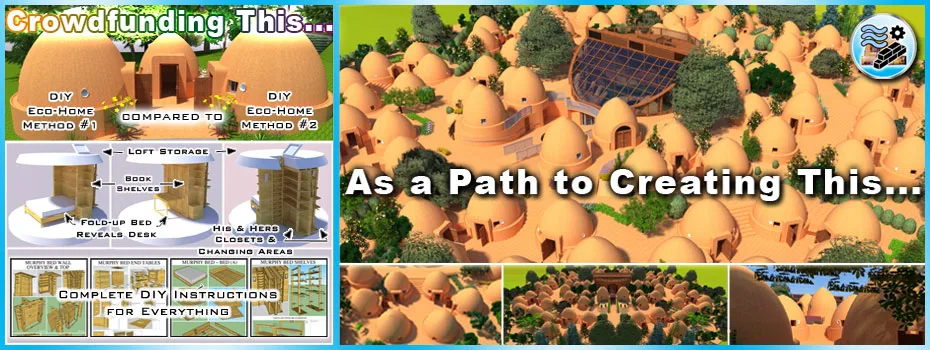
Dome-home Finishing, Water Proofing, and Interior Finish
This page is about dome-home interior and exterior finishing details. It is meant to be the most complete, comprehensive, and easy-to-follow guide available for waterproofing, weatherizing, and finishing domes built with earthbag or aircrete. One Community will be using the Aircrete and Earthbag Crowdfunding Campaign to make it even better.
- Related Pages and Getting Involved
- What is This
- Why Open Source This
- Tools and Materials (coming)
- Exterior Water Proofing Above Ground
- Window and Door Openings
- Rainwater Catchment
- Interior Water Proofing
- Water Proofing Below Ground
- Resources
- FAQ
NOTE: THIS PAGE IS NOT CONSIDERED BY US TO BE A COMPLETE AND USABLE TUTORIAL UNTIL
WE FINISH THE CROWDFUNDING CAMPAIGN AND ADD ALL THE VIDEOS AND EXPERIENCE FROM
THAT BUILD TO THIS PAGE – IN THE MEANTIME, WE WELCOME YOUR INPUT AND FEEDBACK
HERE ARE LINKS TO WHO WE ARE AS AN ORGANIZATION (click icons for complete pages)
VISIT THESE DETAILED PAGES FOR MORE ON THE COMPLETE VILLAGE PLANS (click icons)
WAYS TO CONTRIBUTE TO EVOLVING THIS SUSTAINABILITY COMPONENT WITH US
SUGGESTIONS â” Â CONSULTING â” Â MEMBERSHIP â” Â OTHER OPTIONS
CLICK THESE ICONS TO JOIN US THROUGH SOCIAL MEDIA
WHAT IS THIS
 Maintaining a dry dome, both above and below ground is a key to the longevity and comfort of any structure. How you address this will depend on the climate at your building location, the framework of your budget, and availability of materials (especially on site). In this discussion we are separating the topic into above-ground and below-ground approaches. This page will teach the dome-home finishing, water proofing, and interior finish specifics for both the aircrete and earthbag construction dome homes. Open sourcing these details will help us decide which building method is truly best for us to build what is currently planned as the Earthbag Construction Village.
Maintaining a dry dome, both above and below ground is a key to the longevity and comfort of any structure. How you address this will depend on the climate at your building location, the framework of your budget, and availability of materials (especially on site). In this discussion we are separating the topic into above-ground and below-ground approaches. This page will teach the dome-home finishing, water proofing, and interior finish specifics for both the aircrete and earthbag construction dome homes. Open sourcing these details will help us decide which building method is truly best for us to build what is currently planned as the Earthbag Construction Village.
WHY OPEN SOURCE DOME-HOME FINISHING
Dome-home finishing is more challenging than finishing a home with a traditional roof because domes endure more direct exposure when it rains. Traditional finishing methods are also not very eco-friendly. Our goal with this page is to demonstrate a dome-home finishing solution that is economical, durable, artistic, do-it-yourself doable, and significantly more earth friendly than traditional methods.
By doing this we will educate people and raise public awareness. This will stimulate the DIY construction industry as we help people to replicate our efforts. This increased exposure and DIY implementation will also provide an increase in business and interest for training and help from individuals and organizations that focus on providing a building service for those needing and wanting additional help.
TOOLS AND MATERIALS
 When undertaking a project and acquiring tools and materials seek out those that best fit your situation. Quality of tools generally correlates with price, but thorough research can save you money if you have the time. What works for us, may not necessarily work for you, but in many cases it will. We share our list here with the hope that it will act as a useful guide for saving you time, money, and frustration. To fully engage in this action, the following tools and materials are our suggestions. If you find a better substitute, please let us know.
When undertaking a project and acquiring tools and materials seek out those that best fit your situation. Quality of tools generally correlates with price, but thorough research can save you money if you have the time. What works for us, may not necessarily work for you, but in many cases it will. We share our list here with the hope that it will act as a useful guide for saving you time, money, and frustration. To fully engage in this action, the following tools and materials are our suggestions. If you find a better substitute, please let us know.
EXTERIOR WATERPROOFING ABOVE GROUND
We will incorporate several methods to address water infiltration from above ground and into the interior of the domes. These include:
- Quality of bag compaction
- Render type
- Cement exterior stucco
- Breathable interior earthen plaster
- Window and door openings
- Rainwater catchment
Video coming: Interior versus exterior considerations:
VIDEO COMING OF: IMPORTANT CONSIDERATIONS FOR INTERIOR VERSUS EXTERIOR DOME-HOME FINISHING
SEE OUR HOW TO HELP AND/OR CROWDFUNDING CAMPAIGN PAGE TO HELP CREATE ALL THE TUTORIAL VIDEOS FASTER
Our research concludes that one of the key factors in exterior waterproofing is not only the material choice, thickness, and quality of render application, but equally as important is the thorough tamping of the earthbags for proper compression of the mix within the bags. This factor alone reduces post-construction movement, thereby reducing cracking of any applied render which in turn minimizes leakage potential. Therefore, when filling the bags, it is highly critical to tamp as tightly as possible, leaving no air pockets, so there is no shifting within the bag once it is in place. The bags should lie flat and compressed tightly against one another.
Video coming: How to properly tamp earthbags:
VIDEO COMING OF: HOW TO PROPERLY TAMP EARTHBAGS
SEE OUR HOW TO HELP AND/OR CROWDFUNDING CAMPAIGN PAGE TO HELP CREATE ALL THE TUTORIAL VIDEOS FASTER
Depending on the climate, cement, earthen, or lime-based renders for weatherproofing are commonly used, though other options are available. In geographical locations of low humidity and seasonal rain-free drying times an earthen or lime plaster works well using a two coat system, applying render to a depth of 25mm – 40mm (1-1.5 inches), otherwise a cement based plaster with a double coat of roofing paint over the plaster is recommended.
Lime and earthen plaster on the exterior of a dome doesn’t work well because the dome always take a direct hit of the weather. These plasters are more effective when you construct vertical walls with a traditional roof and generous overhangs. Further, if the walls are protected by a separate roof, then a lightly cement-stabilized earthen plaster or a lime plaster should suffice; but with a dome, a more waterproof heavy cement stucco is necessary.
Our research concludes the best waterproof plaster on a dome exterior is a double layer of concrete-based plaster covered by two coats of roofing paint after the stucco has thoroughly dried. Give the plaster some time to develop small cracks and a generous application of roofing paint will seal those cracks.
Video coming: Mixing plaster for your dome:
VIDEO COMING OF: HOW TO MIX YOUR FIRST PLASTER COAT
SEE OUR HOW TO HELP AND/OR CROWDFUNDING CAMPAIGN PAGE TO HELP CREATE ALL THE TUTORIAL VIDEOS FASTER
Cement stucco is not as breathable, but can be formulated to be somewhat breathable. The question of breathability becomes more of an issue with domes, where the walls/roof must also shed water. If you have plumbing within a dome, install a fan to extract the humid air, otherwise mold will be more likely to occur over time. We will use two layers of cement stucco plaster.
Video coming: Applying stucco layers 1 and 2:
VIDEO COMING OF: HOW TO APPLY PLASTER LAYERS 1 AND 2
SEE OUR HOW TO HELP AND/OR CROWDFUNDING CAMPAIGN PAGE TO HELP CREATE ALL THE TUTORIAL VIDEOS FASTER
If you have exterior cracking but the interior remains intact, it indicates there has been no structural movement but something wrong with the actual exterior plastering. The most common sources would be too thin of an application or inadequate mix ratios. Apply another coat. Some fine cracks, however, are normal and can easily be filled with a couple coats of roofing paint to prevent moisture entry into the structure.
Video coming: Applying roofing paint finishing coats:
VIDEO COMING OF: APPLYING THE FINISHING COAT
SEE OUR HOW TO HELP AND/OR CROWDFUNDING CAMPAIGN PAGE TO HELP CREATE ALL THE TUTORIAL VIDEOS FASTER
The roofing paint we’ve chosen is called “Safecoat DynoFlex Roofguard.” It is a long-lasting low-VOC (volatile organic compound) water-based elastomeric (maintaining its elasticity up to 300%) in high and low temperatures without cracking. It can be applied with a brush, roller or sprayer and protects against water, mildew and harsh weather. It has a low-odor and is odor free when cured. Because it is a water-based product, cleanup is quick and easy like water-based paint. It is non-toxic and safe to apply, even for the chemically sensitive (here’s self-checking guide for chemical sensitivity to products) and contains no formaldehyde, mildewcides or fungicides. It dries white, but can be tinted at the factory by special order. It also has a shelf life of 2 years.
WINDOW AND DOOR OPENINGS
Often times, once you have attained a consistent thickness and comprehensive render, the problem areas for leakage are then the detailing around the structural openings that provide an entry point for moisture. These openings require adequate dormer extensions that keep the water from draining back toward the windows and doors. Don’t minimize the extensions to save costs because the damage created by water infiltration can easily offset any cost savings. Metal flashing around the openings and silicone caulking will also greatly inhibit the entry of any rain-driven rainwater.
Video coming: Special considerations for sealing window and door openings
VIDEO COMING OF: SEALING WINDOW AND DOOR OPENINGS
SEE OUR HOW TO HELP AND/OR CROWDFUNDING CAMPAIGN PAGE TO HELP CREATE ALL THE TUTORIAL VIDEOS FASTER
RAINWATER CATCHMENT
When harvesting rainwater from an earthbag dome, use a plaster that will easily shed the water and not contaminate it. A cement-rich stucco will accomplish this but a molded gutter arrangement built into the exterior plaster design is necessary to capture the water. We are currently researching stable options with the best thus far being a reusable form with a fiberglass, aircrete or stabilized-earth gutter catchment system. With either option, you may need an impervious (double) layer of plastic beneath it to keep water from seeping into the dome from cracks that will likely develop in the gutter. This has been a problem with similar domes in the past, so monitor the gutter and apply roofing paint as necessary if cracks develop.
By catching the water from the dome and distributing it elsewhere before it enters the ground, even though we are waterproofing below ground (see below), it further reduces chances of water infiltration into the structure by eliminating that source of water.
Video coming: Rainwater catchment design
VIDEO COMING OF: DOME HOME RAINWATER CATCHMENT SYSTEM DESIGN
SEE OUR HOW TO HELP AND/OR CROWDFUNDING CAMPAIGN PAGE TO HELP CREATE ALL THE TUTORIAL VIDEOS FASTER
INTERIOR WATER PROOFING
Use an earthen plaster on the interior. In the event of a leak, it is much easier to repair than lime or cement plaster. Earthen plaster is low cost, doesn’t mold and it excels at stabilizing humidity levels in the home. Don’t seal the interior earthen plaster. It is from the interior that we will obtain the breathability via the combination of venturi effect (placing exhaust air vents at the peak of the dome and providing ample inlet air vents near the base, creating a noticeable venturi effect of upward air.), the breathable earthen plaster, and as well cross window ventilation (during a significant portion of the calendar year).
Video coming: Mixing earthen plaster ingredients:
VIDEO COMING OF: HOW TO MIX EARTHEN PLASTER INGREDIENTS
SEE OUR HOW TO HELP AND/OR CROWDFUNDING CAMPAIGN PAGE TO HELP CREATE ALL THE TUTORIAL VIDEOS FASTER
Video coming: 1st coat application of earthen plaster (to fill in major gaps between earthbags):
VIDEO COMING OF: HOW TO APPLY YOUR FIRST EARTHEN PLASTER COAT
SEE OUR HOW TO HELP AND/OR CROWDFUNDING CAMPAIGN PAGE TO HELP CREATE ALL THE TUTORIAL VIDEOS FASTER
Video coming: Earthen plaster scratch coat video to level out and shape interior:
VIDEO COMING OF: HOW TO APPLY AN EARTHEN PLASTER SCRATCH COAT
SEE OUR HOW TO HELP AND/OR CROWDFUNDING CAMPAIGN PAGE TO HELP CREATE ALL THE TUTORIAL VIDEOS FASTER
Video coming: Applying an earthen plaster finishing coat:
VIDEO COMING OF: HOW TO APPLY YOUR FINISHING COAT OF EARTHEN PLASTER
SEE OUR HOW TO HELP AND/OR CROWDFUNDING CAMPAIGN PAGE TO HELP CREATE ALL THE TUTORIAL VIDEOS FASTER
Most solutions for waterproofing will limit dome breathability, but by using an interior earthen plaster it allows breathing from the inside, with the cement based exterior covering addressing the exterior dome waterproofing. There is no fool-proof waterproofing technique but with attention to maintenance you can minimize and resolve water issues as they arise.
BELOW-GROUND WATER PROOFING
Building into the ground for better insulation value requires us to pay particular attention to maintaining a dry interior dome and keeping the water away from the foundation. To maintain a dry interior we will use three different methods of waterproofing: polyethylene plastic, a tar membrane, and a gradual 2-3% sloping of the soil away from the domes.
The double polyethylene moisture barrier is used in the following locations:
- At the base of the dome floor under the rounded gravel preventing any wicking into the floor from the subsurface. on top of the extruded polystyrene insulation within the backfill and sloped away to drain water away from the domes
- Vertically from just below the double bagged gravel up the length of the buttress wall and horizontally under the gutter, finishing about 12″ up between the stem and buttress walls and tucked into place between the bags of the stem wall
- This plastic should be rolled up and protected with a tarp to prevent UV breakdown of the polyethylene plastic during construction
Video coming: Installing your polyethylene moisture barrier:
VIDEO COMING OF: HOW TO INSTALL A POLYETHEYLENE MOISTURE BARRIER FOR YOUR DOME HOME
SEE OUR HOW TO HELP AND/OR CROWDFUNDING CAMPAIGN PAGE TO HELP CREATE ALL THE TUTORIAL VIDEOS FASTER
A tar membrane is utilized as a horizontal separation between the last course of earthbags and 1st course of gravel bags. This a self-sealing membrane that once punctured with the barbed wire will re-seal and maintain its waterproofing ability, providing a continuous seal and preventing any moisture from entering the earthbags from below. The double-bagged gravel below the earthbags should prevent any upward wicking of moisture and the additional tar membrane is added for assurance. Grace Vycor Plus is the product we like most so far.
Video coming: Applying your tar membrane:
VIDEO COMING OF: HOW TO APPLY A TAR BARRIER FOR ADDED BELOW-GROUND MOISTURE PROTECTION
SEE OUR HOW TO HELP AND/OR CROWDFUNDING CAMPAIGN PAGE TO HELP CREATE ALL THE TUTORIAL VIDEOS FASTER
Sloping the landscape gradually away from the domes will help rainwater and snowmelt to drain away from the building. Lasting penetrating rains will naturally be absorbed and go into the ground, eventually reaching the double-polyed styrofoam, which is also sloped away at a 2-3% grade. The water catchment system will also significantly reduce the amount of water penetrating the ground as most of the water hitting the upper shell will fall into the gutter system and be carried away for agricultural use.
Video coming: Landscaping around your dome home
VIDEO COMING OF: HOW TO LANDSCAPE AROUND YOUR DOME HOME TO PROTECT AGAINST MOISTURE
SEE OUR HOW TO HELP AND/OR CROWDFUNDING CAMPAIGN PAGE TO HELP CREATE ALL THE TUTORIAL VIDEOS FASTER
RESOURCES
Coming…
FAQ
Coming…
 One Community
One Community













